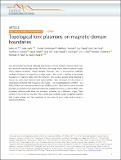Topological kink plasmons on magnetic-domain boundaries
Author(s)
Jin, Dafei; Xia, Yang; Christensen, Thomas; Freeman, Matthew; Wang, Siqi; Fong, King Yan; Gardner, Geoffrey C; Fallahi, Saeed; Hu, Qing; Wang, Yuan; Engel, Lloyd; Xiao, Zhi-Li; Manfra, Michael J; Fang, Nicholas X; Zhang, Xiang; ... Show more Show less
DownloadPublished version (1.455Mb)
Publisher with Creative Commons License
Publisher with Creative Commons License
Creative Commons Attribution
Terms of use
Metadata
Show full item recordAbstract
© 2019, The Author(s). Two-dimensional topological materials bearing time reversal-breaking magnetic fields support protected one-way edge modes. Normally, these edge modes adhere to physical edges where material properties change abruptly. However, even in homogeneous materials, topology still permits a unique form of edge modes – kink modes – residing at the domain boundaries of magnetic fields within the materials. This scenario, despite being predicted in theory, has rarely been demonstrated experimentally. Here, we report our observation of topologically-protected high-frequency kink modes – kink magnetoplasmons (KMPs) – in a GaAs/AlGaAs two-dimensional electron gas (2DEG) system. These KMPs arise at a domain boundary projected from an externally-patterned magnetic field onto a uniform 2DEG. They propagate unidirectionally along the boundary, protected by a difference of gap Chern numbers (± 1) in the two domains. They exhibit large tunability under an applied magnetic field or gate voltage, and clear signatures of nonreciprocity even under weak-coupling to evanescent photons.
Date issued
2019Department
Massachusetts Institute of Technology. Department of Physics; Massachusetts Institute of Technology. Department of Mechanical EngineeringJournal
Nature Communications
Publisher
Springer Science and Business Media LLC